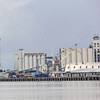Port of L.A. Ready for Calif. Shore-side Power Requirements
Port Invests $180 Million; 25 Berths Equipped with Shore-Side Electric Power
With more berths for ships to plug into shore-side electric power, or Alternative Maritime Power (AMP), than any other port in the world, the Port of Los Angeles said it is fully ready for its terminal operators and ocean carriers to meet California’s new clean air requirements.
“The Port developed and invested heavily in AMP ahead of the regulations to bring the tremendous environmental benefits of shore-side power to our region,” said Gary Lee Moore, Interim Executive Director of the Port of Los Angeles. “A great deal of credit goes to our industry and regulatory partners for working closely with us over the past decade to put us into the position we are today in terms of our shore-side power deployment capacities.”
Effective January 1, 2014, a new California regulation has set shore-side power plug in requirements for container and refrigerated ship fleets, as well as cruise ships. Under the regulation, at least fifty percent of fleet vessel calls must shut down their auxiliary engines and run their vital onboard systems by plugging into shore-side power. The regulation also requires that each fleet reduce its total at-berth emissions generation by at least fifty percent. These requirements will reach eighty percent by 2020.
At the Port of Los Angeles, ships equipped to connect to AMP can now do so at all eight marine container terminals and the Port’s World Cruise Center. Approximately $180 million has been invested over the last decade to equip 25 container and cruise berths with AMP shore-side power infrastructure.
Shipping lines, whose compliance is crucial to securing these air quality benefits, also have invested substantial resources to ensure the regulatory program succeeds. The Pacific Merchant Shipping Association (PMSA), which represents terminal operators and ocean carriers that move cargo through the West Coast ports, estimates the cost of retrofitting a ship to plug into shore-side power can range from $500,000 to $1.5 million, depending on the vessel.
“Programs like this demonstrate the maritime industry’s ongoing commitment to the San Pedro Bay Ports Clean Air Action Plan and responsible environmental practices worldwide,” said T.L. Garrett, Vice President of the PMSA. “This is an extraordinary tale of an industry that has literally turned itself around in less than a decade. No industry has adopted real reforms as quickly as this one to promote a healthier environment.”
“The Port of Los Angeles has been a pioneer in implementing shore power and we applaud their efforts,” said Jack Kitowski, Assistant Chief of the California Air Resources Board’s Stationary Source Division. “The ports and maritime industry have made tremendous strides in meeting the goals set in our Goods Movement Plan, including the shore power regulation, providing significant health benefits for their local communities.”
Shore-side power has unprecedented air quality benefits. Plugging into electric power reduces ship engine emissions of diesel particulate matter, nitrogen oxides (NOx) and sulfur oxides (SOx) by up to 95 percent per vessel call. For example, on average, this reduces 1 ton of NOx per vessel call.
The Port has taken numerous steps to advance the technology and help shipping lines and terminal operators become AMP ready. Five years ago, the Port collaborated with its sister agency, the Los Angeles Department of Water and Power, to establish a preferential rate structure that stabilizes the cost of electricity for shore-side power users and is expected to generate future savings. In 2011, the Port completed AMP work on its World Cruise Center.
Port experts also played a pivotal role in developing the international standard for High Voltage Shore Connection Systems to help ensure that shore-side power technical systems are consistent at ports around the world. The standard was developed over six years and published in 2012. More recently, the Port worked with industry to provide input to the California Air Resources Board in the development of a Regulatory Advisory that establishes steps to assist vessel fleets with the transition to the new shore-side power regulatory requirements during the first six months of 2014.
The Port also continues to support the development of alternative technologies that yield comparable or higher air quality benefits.
The California rules are taking effect as the Port of Los Angeles marks the 10-year anniversary of the first time a container ship anywhere in the world “plugged in.” On June 21, 2004, China Shipping’s Xin Yang Zhou plugged in to a barge-mounted AMP connection while at berth. In 2007, another first was achieved when the NYK Atlas, the first container ship built with AMP capability, plugged into a shore-side power connection at the Port.









